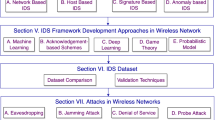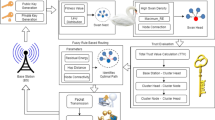Abstract
In wireless, every device can moves anywhere without any infrastructure also the information can be maintained constantly for routing the traffic. The open issues of wireless Adhoc network the attacks which are chosen the forwarding attack that is dropped by malicious node to corrupt the network performance then the information integrity exposure. Aim of the problem that existing methods in Adhoc network for malicious node detection which cannot assure the traceability of the node as well as the fairness of node detection. In this paper, the proposed heterogeneous cluster based secure routing scheme provides trust based secure network for detection of attacks such as wormhole and black hole caused by malicious nodes presence in wireless Adhoc network. The simulation result shows that the proposed model is detect the malicious nodes effectively in wireless Adhoc networks. The malicious node detection efficiency can be achieved 96% also energy consumption also 10% better than existing method.








Similar content being viewed by others
References
Bao F, Chen R, Chang M, Cho JH (2011) Trust-based intrusion detection in wireless sensor networks. IEEE Int Conf Commun (ICC) 2011:1–6
Bhavana N, Mouriya K, Mano jKumar DS (2017) Detection and avoidance of malicious nodes in MANET. Int J Pure Appl Math 116(21):401–407
Chatla AB, Maji B, Habibulla K (2017) A survey of energy aware and identity based encryption protocols in wireless ad-hoc network. J Adv Res Dyn Control Syst 9(12):1464–1473
Chen RC, Hsieh CF, Chang WL (2016) Using ambient intelligence to extend network lifetime in wireless sensor networks. J Ambient Intell Humaniz Comput 7(6):777–788
Debroy BK, Sadi MS, Al-Imran Md (2011) An efficient approach to select cluster head in wireless sensor network. Int J Commun 6(7):529–539
Jamali MAJ (2019) A multipath QoS multicast routing protocol based on link stability and route reliability in mobile ad-hoc networks. J Ambient Intell Humaniz Comput 10(1):107–123
Kar P, Misra S (2016) Reliable and efficient data acquisition in wireless sensor networks in the presence of transfaulty nodes. IEEE Trans Netw Serv Manag.https://doi.org/10.1109/TNSM.2016.2516243
Kukreja D, Dhurandher SK, Reddy BVR (2018) Power aware malicious nodes detection for securing MANETs against packet forwarding misbehavior attack. J Ambient Intell Humaniz Comput 9(4):941–956
Mitchell R, Chen R (2015) Modeling and analysis of attacks and counter defense mechanisms for cyber physical systems. IEEE Trans Reliab 65(1):350–358
Prabha VR, Latha P (2016) Fuzzy trust protocol for malicious node detection in wireless sensor networks. Wirel Pers Commun 94(4):2549–2559
Sampathkumar A, Vivekanandan P (2019) Gene selection using PLOA method in microarray data for cancer classification. J Med Imaging Health Informatics 9(6):1294–1300
Sun B, Li D (2018) A comprehensive trust-aware routing protocol with multi-attributes for WSNs. IEEE Access 6:4725–4741. https://doi.org/10.1109/ACCESS.2017.2786944
Sun B, Shan X, Wu K, Xiao Y (2013) Anomaly detection based secure in-network aggregation for wireless sensor networks. IEEE Syst J 7(1):13–25
Yang Q, Zhu X, Fu H, Che X (2015) Survey of security technologies on wireless sensor networks. J Sensors.https://doi.org/10.1155/2015/842392
Yessembayev A, Sarkar D, Sikder F (2018) Detection of good and bad sensor nodes in the presence of malicious attacks and its application to data aggregation. IEEE Trans Signal Inf Process Netw 4(3):549–563
Zawaideh F, Salamah M, Al-Bahadili H (2017) A Fair trust-based malicious node detection and isolation scheme for WSNs. IT-DREPS Conference, Amman, Jordan, vol 6, p 8
Zhang Z, Zhu H, Luo S, Xin Y, Liu X (2017) Intrusion detection based on state context and hierarchical trust in wireless sensor networks. IEEE Access 5:12088–12102
Author information
Authors and Affiliations
Corresponding author
Additional information
Publisher's Note
Springer Nature remains neutral with regard to jurisdictional claims in published maps and institutional affiliations.
Rights and permissions
About this article
Cite this article
Gomathy, V., Padhy, N., Samanta, D. et al. Malicious node detection using heterogeneous cluster based secure routing protocol (HCBS) in wireless adhoc sensor networks. J Ambient Intell Human Comput 11, 4995–5001 (2020). https://doi.org/10.1007/s12652-020-01797-3
Received:
Accepted:
Published:
Issue Date:
DOI: https://doi.org/10.1007/s12652-020-01797-3




